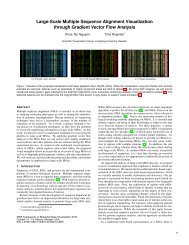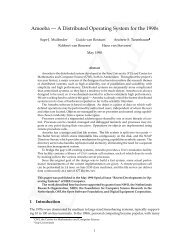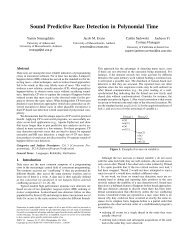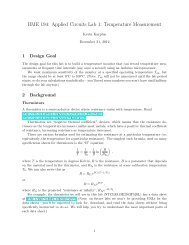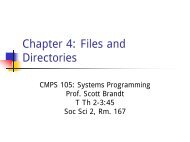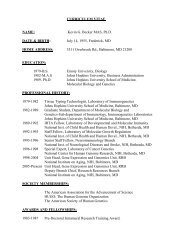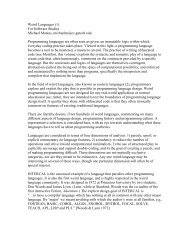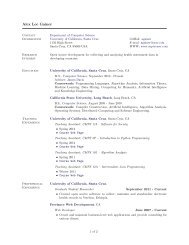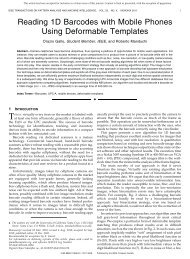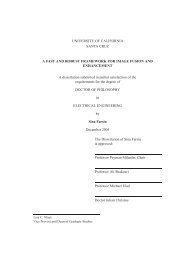Learning binary relations using weighted majority voting
Learning binary relations using weighted majority voting
Learning binary relations using weighted majority voting
Create successful ePaper yourself
Turn your PDF publications into a flip-book with our unique Google optimized e-Paper software.
Machine Leaming, 20, 245-271 (1995)<br />
© 1995 Kluwer Academic Publishers, Boston. Manufactured in The Netherlands.<br />
<strong>Learning</strong> Binary Relations Using Weighted<br />
Majority Voting *<br />
SALLY A. GOLDMAN<br />
Dept. of Computer Science, Washington University, St. Louis, MO 63130<br />
sg@cs.wustl.edu<br />
MANFRED K. WARMUTH manfred@cs.ucsc.edu<br />
Dept. of Computer and Information Sciences, University of California, Santa Cruz, CA 95064<br />
Editor: David Haussler<br />
Abstract. In this paper we demonstrate how <strong>weighted</strong> <strong>majority</strong> <strong>voting</strong> with multiplicative weight updating<br />
can be applied to obtain robust algorithms for learning <strong>binary</strong> <strong>relations</strong>. We first present an algorithm that<br />
obtains a nearly optimal mistake bound but at the expense of <strong>using</strong> exponential computation to make each<br />
prediction. However, the time complexity of our algorithm is significantly reduced from that of previously<br />
known algorithms that have comparable mistake bounds. The second algorithm we present is a polynomial time<br />
algorithm with a non-optimal mistake bound. Again the mistake bound of our second algorithm is significantly<br />
better than previous bounds proven for polynomial time algorithms.<br />
A key contribution of our work is that we define a "non-pure" or noisy <strong>binary</strong> relation and then by exploiting<br />
the robustness of <strong>weighted</strong> <strong>majority</strong> <strong>voting</strong> with respect to noise, we show that both of our algorithms can<br />
learn non-pure <strong>relations</strong>. These provide the first algorithms that can learn non-pure <strong>binary</strong> <strong>relations</strong>.<br />
Keywords: on-line learning, mistake-bounded leaming, <strong>weighted</strong> <strong>majority</strong> <strong>voting</strong>, noise tolerance, <strong>binary</strong><br />
relation<br />
1. Introduction<br />
In this paper we demonstrate how <strong>weighted</strong> <strong>majority</strong> <strong>voting</strong> with multiplicative weight<br />
updating can be applied to obtain robust algorithms for learning <strong>binary</strong> <strong>relations</strong>. Follow-<br />
ing Goldman, Rivest and Schapire (1993), a <strong>binary</strong> relation is defined between two sets<br />
of objects, one of cardinality n and the other of cardinality m. For all possible pairings<br />
of objects, there is a predicate relating the two sets of variables that is either true (1)<br />
er false (0). The relation is represented as an n x rn matrix M of bits, whose (r, j)<br />
entry is 1 if and only if the relation holds between the corresponding elements of the two<br />
sets. Furthermore, there area limited number of object types. Namely, the matrix M is<br />
restricted to have at most k distinct row types among its n rows. (Two rows are of the<br />
same type if they agree in all columns.) This restriction is satisfied whenever there are<br />
only k types of identical objects in the set of n objects being considered in the relation.<br />
We study the problem of learning <strong>binary</strong> <strong>relations</strong> under the standard on-line (or in-<br />
cremental) learning model (Littlestone 1989; Littlestone 1988). The learning session<br />
consists of a sequence of trials. In each trial, the learner taust predict the value of some<br />
* The first author was supported in part by NSF grant CCR-91110108 and NSF National Young Investigator<br />
Grant CCR-9357707 with matching funds provided by Xerox Corporation, Palo Alto Research Center and<br />
WUTA. The second author was supported by ONR grant NO0014-91-J-1162 and NSF grant IRI-9123692.
246 GOLDMAN AND WARMUTH<br />
unknown matrix entry that has been selected by the adversary 1. After predicting, the<br />
learner receives the value of the matrix entry in question as feedback. If the prediction<br />
disagrees with the feedback, then we say the learner has made a mistake. The learn-<br />
ing session continues until the learner has predicted each matrix entry. The goal of the<br />
learner is to make as few prediction mistakes as possible.<br />
One could view each row as a point in {0, 1} ~ and each row type of a <strong>binary</strong> relation<br />
as a cluster of points in {0, 1} m that are distance zero from each other. Initially, the<br />
learner knows nothing about how the points may be clustered, yet as the learning session<br />
proceeds the learner must infer both how the points are clustered (since this will be<br />
essential in reducing the mistakes) and the value of the m bits defining each cluster. We<br />
thus use the term cluster rather than row type when talking about the grouping of the<br />
rows.<br />
One contribution of this paper is a formal definition for the problem of learning <strong>binary</strong><br />
<strong>relations</strong> in which the clusters are not "pure" in that two rows in the same cluster may<br />
not be exactly the same. In other words, we remove the requirement that all points in a<br />
cluster are distance zero from each other. Thus even if the target matrix were known there<br />
remains an interesting clustering problem that one could address, namely, what clustering<br />
achieves the optimal tradeoff between the nnmber of clusters and the distances between<br />
the points in the clusters. Of course, our learning algorithm must perform the clustering<br />
in an on-line manner while also predicting the values of unknown matrix entries. By<br />
viewing the problem of learning <strong>binary</strong> <strong>relations</strong> under this more general formulation, we<br />
achieve two important goals. First, such a modification in the definition of the learning<br />
problem much better matches the motivation provided by Goldman, Rivest, and Schapire<br />
(1993). Second, we can greatly reduce the mistake bounds obtained under the original<br />
formulation of Goldman et al. since now a group of rows that have slight differences can<br />
be viewed as a single cluster rather than having each row as its own cluster. In addition,<br />
the final weights of the second algorithm we present may be used to obtain a solution to<br />
the problem of how to cluster the rows of the target matrix.<br />
A second contribution of this paper is two new algorithms (both based on <strong>weighted</strong><br />
<strong>majority</strong> <strong>voting</strong> with multiplicative weight updating) to learn both pure and non-pure<br />
<strong>binary</strong> <strong>relations</strong>. Weighted <strong>majority</strong> <strong>voting</strong> provides a simple and effective method for<br />
constructing a learning algorithm .A that is provided with a pool of "experts", one of<br />
which is known to perform weil, hut A does not know which one. Associated with<br />
each expert is a weight that gives ./t's confidence in the accuracy of that expert. When<br />
asked to make a prediction, A predicts by combining the votes from its experts based<br />
on their associated weights. When an expert suggests the wrong prediction, A passes<br />
that information to the given expert and reduces its associated weight. In this work, we<br />
use a multiplicative weight updating scheme to adjust the weights. Namely, the weight<br />
associated with each expert that mispredicts is multiplied by some weight 0 _ 0 this algorithm is robust against noise in the data. This robust nature of<br />
<strong>weighted</strong> <strong>majority</strong> <strong>voting</strong> enables us to apply our algorithms to the problem of learning<br />
non-pure <strong>relations</strong> by viewing discrepancies between the rows in the same cluster as<br />
noise.
LEARNING BINARY RELATIONS 247<br />
When <strong>using</strong> <strong>weighted</strong> <strong>majority</strong> <strong>voting</strong> there is a tradeoff between the number of experts<br />
(i.e. the number of weights being combined) and the computation time needed to make<br />
each prediction. Our first algorithm applies a <strong>weighted</strong> <strong>majority</strong> scheme with km/k!<br />
weights to the problem of learning <strong>binary</strong> <strong>relations</strong>. We show that the mistake bound of<br />
this algorithm nearly matches the information theoretic lower bound. While the compu-<br />
tation time needed to make each prediction is exponential, it is still significantly reduced<br />
from that used by the halving algorithm (Barzdin & Freivald, 1972; Littlestone 1988;<br />
Angluin 1988) 2. In out second algorithm we apply a <strong>weighted</strong> <strong>majority</strong> <strong>voting</strong> scheme<br />
that uses only a polynomial number of weights and thus can make each prediction in<br />
polynomial time. While the mistake bound proven for this algorithm is not near optimal,<br />
with respect to what can be obtained with unlimited computation, it is significantly better<br />
than previous bounds obtained by polynomial time algorithms. We first present and ana-<br />
lyze our two algorithms for the problem of learning pure <strong>binary</strong> <strong>relations</strong>. We then show<br />
how to exploit the robustness of <strong>weighted</strong> <strong>majority</strong> <strong>voting</strong>, to generalize both of these<br />
algorithms to obtain the first known algorithms for learning non-pure <strong>binary</strong> <strong>relations</strong>.<br />
Our second algorithm has two novel features that required the use of a new method<br />
for analyzing the mistake bound. This algorithm runs n copies of a <strong>weighted</strong> <strong>majority</strong><br />
<strong>voting</strong> scheme in parallel where in each trial only one of the n copies is active. However,<br />
all n copies share weights and thus cooperatively work to learn the target relation.<br />
Another unusual property of out <strong>voting</strong> scheine is that all experts begin with incomplete<br />
information and thus do not always know how to make each prediction. Furthermore,<br />
the prediction an expert would make for any given matrix entry can change over time.<br />
(In fact, initially no experts will know how to vote for any matrix entry.) As the learning<br />
session proceeds all experts monotonically gain information and thus know how to vote<br />
more orten. Thus to bound the number of mistakes made by our second algorithm, we<br />
taust determine the minimum rate at which information is being gained across the n<br />
copies of our <strong>voting</strong> scheme.<br />
The remainder of this paper is organized as follows. In the hext section, we discuss<br />
the halving algorithm and the particular <strong>weighted</strong> <strong>majority</strong> <strong>voting</strong> scheine, WMG, that<br />
we apply. In Section 3 we present out two different algorithms for applying WMG to the<br />
problem of learning a <strong>binary</strong> relation. In Section 4 we formally define the problem of<br />
learning non-pure <strong>binary</strong> <strong>relations</strong>, and demonstrate how the robust nature of WMG can<br />
be exploited to handle such noise. In Section 5 we present out main result. Namely, we<br />
provide a technique that enables us to prove an upper bound on the number of mistakes<br />
made by out polynomial-time algorithm for learning non-pure <strong>binary</strong> <strong>relations</strong>. Finally,<br />
in Section 6 we close with some concluding remarks.<br />
2. Preliminaries<br />
In the noise-free setting, if the learner has unlimited computation time then the halving<br />
algorithm (Barzdin & Freivald, 1972; Littlestone 1988; Angluin 1988) typically performs<br />
very well. The halving algorithm predicts according to the <strong>majority</strong> of the <strong>relations</strong> that<br />
are consistent with the completed trials, and thus each mistake halves the number of<br />
remaining <strong>relations</strong>. Since the number of <strong>binary</strong>'<strong>relations</strong> is at most 2kmk~/k! the
248 GOLDMAN AND WARMUTH<br />
standard halving algorithm makes at most<br />
lg(2Æ~k~/k!) = km + nlgk- Igk!<br />
_< km + ~ lg k - k lg(Æ/~)<br />
= km+(n-k) lgk+klge<br />
mistakes 3. The halving algorithm can be viewed as keeping 2kmkn/k! weights, one<br />
weight per possible <strong>binary</strong> relation. Initially, all weights start at 1, and whenever a<br />
<strong>binary</strong> relation becomes inconsistent with the current partial matrix, its weight is set to<br />
0. To make a prediction for a given matrix entry, each <strong>binary</strong> relation votes according<br />
to its bit in that entry. Since the halving algorithm predicts according to the <strong>majority</strong> of<br />
consistent <strong>relations</strong> (i.e. those with weight 1), each mistake halves the total weight in<br />
the system. Since the initial weight is 2kmk'~/k[ and the final weight is at least 1, at<br />
most km + (n - k) lg k + k lg e mistakes can occur.<br />
Observe that the time used to make each prediction is linear in the number of weights.<br />
Thus we are interested in algorithms that use a small number of weights in representing<br />
their hypotheses. The algorithms we present update the weights according to a variant<br />
of the <strong>weighted</strong> <strong>majority</strong> algorithm of Littlestone and Warmuth (1989) called WMG. We<br />
view WMG as a node that is connected to each expert (or input) by a <strong>weighted</strong> edge. The<br />
inputs are in the interval [0, 1]. An input x of weight w votes with weight xw for 1 and<br />
with weight (1 -x)w for 0. The node "combines" the votes of the inputs by determining<br />
the total weight qo (respectively qa) placed on 0 (respectively 1) and predicts with the<br />
bit corresponding to the larger of the two totals (and for the sake of discreteness with 1<br />
in case of a tie). After receiving feedback of what the prediction should have been, for<br />
each input, the fraction of the weight placed on the wrong bit is multiplied by/3, where<br />
/3 C [0, 1). Thus the weight w of an input x becomes (1 - x + x/3)w if the feedback is<br />
0 and ((1 - x)/3 + x)w if the feedback is 1. If/3 = 0 then the total weight halves in<br />
each trial in which the node makes a mistake and we obtain an analysis like that of the<br />
halving algorithm.<br />
3. Our Algorithms For Applying WMG<br />
In this section we describe two different methods for applying WMG to the problem of<br />
learning a <strong>binary</strong> relation. The first algorithm uses one node and km/k! weights. Thus<br />
the number of weights is still exponential but lower than the number of weights used by<br />
the halving algorithm by a multiplicative factor of 2 km. For this case, the analysis is<br />
straighfforward, and for the noise-free case, the bounds achieved are nearly optimal with<br />
respect to the known information-theoretic lower bound. The purpose of this algorithm<br />
is to show what is possible when computational resources are cheap. In the second<br />
algorithm we use one hode for each of the n rows and one weight for each pair of rows<br />
(i.e. (~) weights). Proving bounds for the second algorithm is much more involved and<br />
is the focus of the paper. The bounds obtained are non-optimal when compared to those<br />
obtained when computation time is not a concern. However, our bounds are significantly<br />
better than previous bounds obtained by a polynomial algorithm.
LEARNING BINARY RELATIONS 249<br />
~,~,.<br />
kn/k! partitions<br />
Figure 1. This figure illustrates how the <strong>voting</strong> works in our first algorithm. In this example k = 2. We use<br />
the two degrees of shading to indicate how the rows of the matrices are partitioned. Thus on the fight we have<br />
shown the partially known matfix under three different partitions. Just to the left of each partition we show<br />
its vote for the unknown matrix entry. Recall that a partition <strong>voting</strong> with 1/2 can be viewed as a vote of 1<br />
with half of its weight and a rote of 0 with half of its weight. So the overall prediction made in this example<br />
is 1 if and only if w2/2 + ... + wk~ /k! > Wl -}- w2/2 -k ....
250 GOLDMAN AND WARMUTH<br />
We now describe our two algorithms in more detail. In the first algorithm we use<br />
one weight per partition of the n rows into at most k clusters (i.e. kn/k! weights).<br />
Initially all weights are set to 1. To make a prediction for a new matrix entry, each<br />
partition votes as follows: If a column of the cluster to which the new entry belongs has<br />
already been set then vote with the value of this bit; otherwise, vote with 1/2 ca<strong>using</strong><br />
the weight to be split between the votes of 0 and 1. Our algorithm predicts according<br />
to the <strong>weighted</strong> <strong>majority</strong> of these rotes (see Figure 1). Recall that after receiving the<br />
feedback WMG multiplies the fractions of the weights that were placed on the wrong<br />
bit by/3. By selecting /3 = 0, the weight of partitions that predict incorrectly (and are<br />
thus inconsistent with the partial matrix) are set to zero and the weights of all partitions<br />
that split their vote are halved.<br />
After all entries of the target matrix are known, the correct partition has weight at least<br />
2 -km since it never predicted incorrectly, and split its vote at most km times. Since<br />
the initial weight is kn/k!, we obtain the mistake bound of km + (n - k) lg k + k lg e<br />
just as for the halving algorithm. (Actually, orte can show that when /3 = 0 then the<br />
first algorithm simulates the halving algorithm with k~/k! weights instead of 2kmk~/k!<br />
weights). Note that the mistake bound of this algorithm is essentially optimal since<br />
Goldman, Rivest, and Schapire (1993) prove an information-theoretic lower bound of<br />
km + (1% - k)[lg kJ mistakes. While this algorithm has assumed that an upper bound<br />
on h is known, if no such bound is provided the standard doubling trick can be applied.<br />
Namely, the learner begins with an estimate, /~ = 1, as an upper bound for k. If the<br />
algorithm fails (i.e. makes too many mistakes) then /~ is doubled and the process in<br />
repeated. Once k _> k the algorithm will succeed. Observe that the final value k I of<br />
will be less than 2k. Also, since k is growing ~ an exponential rate, the computation<br />
time and mistakes made during the iteration with k = kf dominates the other runs. More<br />
specifically the number of mistakes made by this variation for k unknown is at most<br />
lg kf<br />
Z (2im + ni - i2 i + 2 i lg e)<br />
/=0<br />
1%<br />
= 2kfm + -~ lg/eX (lg ky + 1)(2/of(lg/of - 1) + 2) + 2kl lg e<br />
< 2/¢fra + 2(lg/of + 1) 2 - 2/¢f(lgkf - 1) + 2kflge<br />
1%<br />
LEARNING BINARY RELATIONS 251<br />
l<br />
J<br />
i~iiii:iii~i~ ~<br />
w l i~:~i~!:~il ¸¸~ i<br />
r : : : I<br />
w3 1<br />
0 .... iii!!<br />
0 1<br />
Figure 2. This figure illustrates how predictions are made in our second algorithm. The <strong>weighted</strong> <strong>majority</strong><br />
node corresponding to row r (heavily shaded) is used to predict Mrj. The predictions of the inputs coming<br />
from the nodes are shown. So for this example the shaded node predicts 1 if wl/2 + w2 > wl/2 + w3 + w4<br />
and oredicts 0 otherwise.<br />
M
252 GOLDMAN AND WARMUTH<br />
the learning problem among themselves. Assume M~j is the next value to predict. To<br />
make its prediction, the node for row r combines the votes of the n - 1 inputs from<br />
column j of matrix M. Each node r ~ ¢ r votes with the weight w(er
LEARNING BINARY RELATIONS 253<br />
Learn-Relation(O _< 7 < 1)<br />
For all r,r' such that (r ¢ r') initialize w(e~
254 GOLDMAN AND WARMUTH<br />
in which the patient is given a fairly low dose of the allergen, or an intradermal (under<br />
the skin) test in which the patient is given a larger dose of the allergen. What options<br />
does the allergist have in testing a patient for a given allergen? He/she could just perform<br />
the intradermal test (option 0). Another option (option 1) is to perform an epicutaneous<br />
test, and if it is not conclusive, then perform an intradermal test. Which option is best?<br />
If the patient has no allergy or a mild allergy to the given allergen, then option 0 is best,<br />
since the patient need not return for the second test. However, if the patient is highly<br />
allergic to the given allergen, then option 1 is best, since the patient does not experience<br />
a bad reaction. The allergist's goal here is to minimize the number of prediction mistakes<br />
in choosing the option to test each patient for each allergen. Although Goldman et al.<br />
explore several possible methods for the selection of the presentation order, here we only<br />
consider the standard worst-case model in which an adversary determines the order in<br />
which the patient/allergen pairs are presented.<br />
This example makes an assumption that is a clear oversimplification. Namely, they<br />
assume that there are a common set of "allergy types" that occur often and that most<br />
people fit into one of these allergy types. Thus the allergy types become the clusters<br />
of the matrix. However, while it is true that often people have very similar allergies,<br />
there are not really pure allergy types. In other words, it is unreasonable to assume that<br />
all rows in the same cluster are identical but rather they are just close to each other.<br />
Without this flexibility one may be required to have most patient's allergies correspond<br />
to a distinct allergy type. Henceforth, we refer to the original formulation of the problem<br />
of learning <strong>binary</strong> <strong>relations</strong> in which all clusters are "pure" as learning pure <strong>relations</strong>.<br />
We propose the following generalization of the problem of learning <strong>binary</strong> <strong>relations</strong><br />
that we refer to as learning non-pure <strong>relations</strong>. For any column c of bits, let N0(c) be<br />
the number of zeros in c. Likewise, let .A/'I (c) be the number of ones in c. Suppose that<br />
the rows of the matrix are partitioned into a set of k clusters p = {S~,..., Sk}. Let<br />
S] denote the jth column of the cluster (or submatrix) S< For each cluster we define a<br />
distance measure<br />
m<br />
d(S{) = Z min{Afo(S]),Hl(S])}<br />
j=l<br />
In other words, think of defining a center point for partition S i by letting the value of<br />
column j in this center be the <strong>majority</strong> vote of the entries in S}. Then d(S i) is just the<br />
sum over all rows s in S ~ of the Hamming distance between s and this center point.<br />
We define the noise of partition p, c~p, as<br />
m<br />
ap= Z d(Si)= Z Zmin{N'°(S})'Afl(SJ )}'<br />
S i Ep S i Ep j=l<br />
and the size of partition p, kp, as the number of clusters in partition p. For each cluster<br />
77%<br />
i and column j, we define ~i,j : min{N'0(Sj),N't(S})}, and 6i = ~j=l 5
LEARNING BINARY RELATIONS 255<br />
We now discuss both of our algorithms when applied to the problem of learning non-<br />
pure <strong>relations</strong> and give bounds for each. The key to our approach is to view minor<br />
discrepancies between rows in the same cluster as noise. This greatly reduces the mistake<br />
bounds that one can obtain when <strong>using</strong> the original formulation of Goldman, Rivest, and<br />
Schapire (1993) by reducing the number of clusters. The robust nature of the <strong>weighted</strong><br />
<strong>majority</strong> algorithm enables us to handle noise.<br />
To demonstrate our basic approach, we now show that our first algorithm (i.e. the one<br />
<strong>using</strong> kn/k! weights) can learn a non-pure relation by making at most 6<br />
{ (~- k)lnk + k + ~~1~ } }<br />
min kpm + ap + in ~<br />
1+~<br />
mistakes in the worst case, where 0 _
256 GOLDMAN AND WARMUTH<br />
Slow-Learn-Relation(0 _ No then partition i predicts that Mr i = 1<br />
Else partition i predicts that M~j = 0<br />
Let Ro be the set of all partitions that predict Mr 9 = 0<br />
Let R1 be the set of all partitions that predict M w = 1<br />
Let Wo = ~ieRo wi + ~ieR-(RoUR~) Wi/2<br />
Let W1 = ~ieR~ w~ + ~ieR-(RoUR~) wi/2<br />
If W1 > Wo predict 1<br />
Else predict 0<br />
3. Receive correct value for M~~<br />
4. If the prediction of the algorithm was wrong then update the weights as follows<br />
For 1 < i < kn/k!<br />
If partition i made a prediction of 1/2 then let ws e- wi/2 +/3 • w~/2<br />
If partition i made an incorrect prediction (of 0 or 1) then let w~ ~- ws •/3<br />
Figure 4. Our algorithm that uses kn/k! weights to obtaln an nearly optimal algorithm for learning <strong>binary</strong><br />
<strong>relations</strong>. We would obtain the same mistake bound if Step 4 is performed at each step regardless of whether<br />
a mistake occurred.
LEARNING BINARY RELATIONS 257<br />
Solving for tt gives the bound given in Equation (1).<br />
An interesting modification of our first algorithm would be to consider all rows in<br />
the same group as row r and then predict with the number of l's already known in<br />
column j divided by the total number of known entries in column j (i.e. a prediction of<br />
N1/(No + N1) <strong>using</strong> the notation of Figure 4). We did not use this rule because it is<br />
harder obtain a lower bound on the final weight in the system.<br />
Finally, by applying the results of Cesa-Bianchi, Freund, Helmbold, Haussler, Schapire,<br />
and Warmuth (1993) we can tune/3 as a function of an upper bound c~ on the noise.<br />
LEMMA 1 (Cesa-Bianchi, Freund, Helmbold, Haussler, Schapire & Warmuth, 1993)<br />
For any real value z > 0 or z = oc,<br />
z 2 + in a z2<br />
g(z)
258 GOLDMAN AND WARMUTH<br />
: min {kprn + 3C~p + 2V/Ct((n - k)lnk + k)+ (n- k)lgk + klge}<br />
for our first algorithm, where the minimum is taken over all partitions p of size at most<br />
with noise at most c~, and kp denotes the size and c~p the noise of partition p.<br />
For the above tuning we needed an upper bound for both the size and the noise of the<br />
partition. If an upper bound for only one of the two is known, then the standard doubling<br />
trick can be used to guess the other. This causes only a slight increase in the mistake<br />
bound (see Cesa-Bianchi, Freund, Helmbold, Haussler, Schapire, and Warmuth (1993)).<br />
Note that in the above mistake bound there is a subtle tradeoff between the noise Ctp and<br />
size kp of a partition p.<br />
Recall that when this first algorithm is applied in the noise-free case that it essentially<br />
matches the information-theoretic lower bound. An interesting question is whether or<br />
not it can be shown to be essentially optimal in the case of learning non-pure <strong>relations</strong>.<br />
As we show in the next section (Theorem 3), when <strong>using</strong> the second algorithm for<br />
[earning non-pure <strong>relations</strong>, our algorithm makes at most<br />
min ~ {hpm + 13mn21gk+4c~pmn (1- -~n) +mni24cm (1- -~n) lnk<br />
mistakes in the worst case, where the minimum is taken over all partitions p, and kp<br />
denotes the size and C~p the noise of partition p where kp < k and C~p _< c~.<br />
5. Algorithm Two: A Polynomial-time Algorithm<br />
In this section we analyze our second algorithm, Learn-Relation, when applied to learning<br />
non-pure <strong>relations</strong>. (Recall that Learn-Relation is shown in Figure 3.) The mistake bound<br />
of Theorem 2 obtained for this algorithm is larger than the mistake bound of the first<br />
algorithm. However this algorithm uses only (~) weights as opposed to exponentially<br />
many.<br />
We begin by giving an update that is equivalent to the one used in WMG (Littlestone<br />
& Warmuth, 1989). Recall that in WMG if x is the prediction of an input with weight w,<br />
then ifthe feedback is the bit p then w is multiplied by 1 - (1 -/3)]x - pl for/3 E [0, 1).<br />
If/3 = 3,/(2 - ~,), then for our application the update of WMG can be summarized as<br />
follows<br />
• If a node predicts correctly (so, ]x - pl = 0) its weight is not changed.<br />
• If a node makes a prediction of 1/2 then its weight is multiplied by 1/(2 - 3,).<br />
• If a node predicts incorrectly (so, ]x - Pt = 1) then its weight is multiplied by<br />
~/(2 - ~).
LEARNING BINARY RELATIONS 259<br />
In the new update all factors in the above algorithm are simply multiplied by (2 - "y).<br />
This update is used in our Algorithm Learn-Relation('y) since it leads to simpler proofs.<br />
Because <strong>voting</strong> is performed by a <strong>weighted</strong> <strong>majority</strong> vote, the predictions made by the<br />
two schemes are identical. In order to use the analysis technique of Littlestone and<br />
Warmuth we must obtain a lower bound for the final weight in the system. However,<br />
<strong>using</strong> WMG the weight in the system is decreased by nodes that do not predict, and thus<br />
we would have to compute an upper bound on the total number of times that this occurs.<br />
Thus to simplify the analysis, we have modified the update scheme (i.e. at each step we<br />
multiplied all weights by (2 - 3/)) so that the weights of nodes that do not predict remain<br />
unchanged.<br />
5.1. The Analysis<br />
In this section we compute an upper bound on the number of mistakes made by Learn-<br />
Relation. os ô~£<br />
We begin with some preliminaries. Ler fzx = -~~ , fyy = õ-Uv' °~I and fzy = . A<br />
function f : N --+ ~ is concave (respectively convex) over an interval D of N if for<br />
all x E D, fxx(x) 0). In our analysis we repeatedly use the following<br />
variants of Jensen's inequality. Ler f be a function from ~ to N that is concave over<br />
some interval D of N. Let q E JV', and let xl,x2,.. ,Xq E D. Then<br />
q q<br />
xi = U ~ E f(xi)
260 GOLDMAN AND WARiVIUTH<br />
We now give an overview of the proof of our main result along with several key<br />
lemmas that are used in the proof. Let p be any partition of size kp and noise c~p. We<br />
note that the partition p is fixed throughout the analysis. Furthermore quantities such<br />
as g, Fi, ~~ (defined below) depend implicitly on p. Let # denote the total number of<br />
mistakes made by the learner, and let #i denote the number of mistakes that occur when<br />
kp<br />
the learner is predicting an entry in a row of cluster i. (Thus, ~i=l #i = #-) Let ni be<br />
kp<br />
the number of rows in cluster i. (So n = ~i=l nj.) Let A be all (~) edges and the set<br />
g contain all edges connecting two rows of the same cluster. We further decompose g<br />
into gl,..-, gkp where gi contains all edges connecting two rows in the same cluster i<br />
of p. Observe that/gd = n~(n~-l) 2 • When making an erroneous prediction for M~j, we<br />
define the force of the mistake to be the number of rows in the same cluster as row r<br />
for which column j was known when the mistake occurred. Ler Fi be the sum of the<br />
forces of all mistakes made when predicting an entry in a row of cluster i.<br />
Recall that the noise of a partition p is defined as<br />
O~p<br />
m<br />
d(S~) = E E min{Af°(S~)'N'l(S~ )} =<br />
S i Cp S ~ Cp J= 1<br />
~~ kp<br />
i=1 j=l i=1<br />
We now define Ji to be the number of times that a weight in gi is multiplied by 3"<br />
when making a prediction for an entry in cluster i. That is, Ji is the total number of<br />
times, over all trials in the learning session in which a mistake occurs, where an entry in<br />
cluster i incorrectly predicts the value of an entry in cluster i (<strong>voting</strong> with all its weight).<br />
We now give the key lemma used in our main proof. For ease of exposition, let<br />
a = lg(2 - 3`) = lg l--4-fi 2 and b=lg(2-'~'~ = lg~.<br />
\'Y2<br />
LEMMA 2 For each i < i < kp,<br />
1<br />
Fi = b ji + - ~-~"<br />
eE/~<br />
Proof: We begin by noting that, if C~p = 0, then J~ = 0 and the number of times some<br />
weight in gi is multiplied by (2 - 7) equals Fi. Thus, in the noise-free case, it follows<br />
that (2-7) Fz = [IeeE, w(e). When C~p > 0, then Fi is the number of times some weight<br />
in gi is multiplied by either (2 - 3') or 7. Since the number of times some weight in gi<br />
is multiplied by 3' is Ji we have that<br />
= H ~(~).<br />
eßg~<br />
Taking logarithms of both sides we obtain the stated result.<br />
Note that if ni = 1 then Ji = Igi[ = Ei = 0. The proof of our main theorem uses<br />
Lemma 2 as its starting point. We first obtain (Lemma 4) a lower bound for F~ that<br />
[]
LEARNING BINARY RELATIONS 261<br />
depends on the total number of mistakes, #i, made by our algorithm when making a<br />
prediction for an entry in cluster i. Next we must determine the maximum amount by<br />
which the "noisy" entries of the submatrix S i cause the weights in gi to be "weakened"<br />
(i.e. multiplied by "7) instead of being "strengthened" (i.e. multiplied by (2- "7)) as<br />
desired. In Lemma 5 we show how Ji can be upper bounded in terms of 6i, the noise<br />
within cluster i. Finally in Lemma 7 we obtain an upper bound for the sum of the<br />
logarithms of the weights. We do this by observing that the total weight in the system<br />
never increases and then use the convexity of the logarithm function. The proof of<br />
our main theorem essentially combines all the lemmas and uses an additional convexity<br />
argument for combining the contributions from all clusters.<br />
We now obtain a lower bound for Fi. In order to obtain this lower bound, it is crucial<br />
to first obtain an upper bound on the number of mistakes for a given cluster and given<br />
force. This quantity characterizes the rate at which the <strong>weighted</strong>-<strong>majority</strong> nodes are<br />
gaining information.<br />
LEMMA 3 For each cluster r and force f there are at most m mistakes of force f.<br />
Proof: We use a proof by contradiction. Suppose that for cluster i the learner makes<br />
m + 1 force f mistakes. Then there must be two mistakes that occur for the same<br />
column. Suppose the first of these mistakes occurs when predicting Mrj and the second<br />
occurs when predicting M«j where both rows r and r' are in cluster i. However,<br />
after making a force f mistake when predicting Mrj that entry is known and thus the<br />
force of the M«j mistake taust be at least f + 1 giving the desired contradiction.<br />
We now compute a lower bound for the force of the mistakes made when predicting<br />
entries in cluster i.<br />
LEMMA 4 For any 1 < i < kp,<br />
Fi>max #i-m, 2m 2 "<br />
Proof: We proceed by showing that both expressions above are lower bounds for Fi.<br />
Ler {x) ~ denote a sequence containing the symbol x repeated m times. Let ~ri denote<br />
the sum of the first #i elements of the sequence (0)~(1)~(2) ~.. -. From Lemma 3 it<br />
follows that Fi _> cri. Thus, clearly our first lower bound<br />
Fi > #i - m<br />
follows since all but m mistakes have force at least one.<br />
We now compute a more sophisticated lower bound on cri. Ler s(x) z<br />
= ~~:~ k =<br />
z(~+l) Using the structure illustrated in Figure 5 it is easily seen that<br />
2 "<br />
F{ > m s([~] -1)- (m[~]-#O (U~] -I)
262 GOLDMAN AND WARMUTH<br />
0 0 0 -.. 0<br />
1 1 1 --- 1<br />
[~I-I ... [~I-1 I<br />
Figure 5. FirSt/zi elements of the sequence (0) m {1) m (2) m ....<br />
= ([--~1- 1)(#i- 2[--~] )<br />
P~ #4 (1 - d)dm<br />
- +<br />
2m 2 2<br />
> #2 #i<br />
- 2m 2'<br />
[ 1-2 .-- [ 1-2<br />
• t<br />
where d = I~] - ~m and the last inequality follows from the observation that 0 _< d < 1.<br />
This completes the proof of the lemma. •<br />
Observe that the simple linear bound is a better lower bound only for m < #i < 2m.<br />
Next, we capture the <strong>relations</strong>hip between Ji and the noise within cluster i of the<br />
partition to obtain an upper bound for Ji.<br />
LEMMA 5 For 1 < i < kp,<br />
Ji < 6~ni 52<br />
770,"<br />
Proof: For ease of exposition, we assume that for each cluster i and column j, the<br />
<strong>majority</strong> of the entries in S~, are 1. Thus 6~,j is exactly the number of 0's in Sj. Observe<br />
that for every known 0 entry in @, the quantity Ji is increased by one whenever the<br />
learner makes a prediction error when predicting the value of an entry in S} that is a 1.<br />
Thus, in the worst case, each of the 6i,j entries in S~ that are 0 could cause Ji to be<br />
incremented for each of the n~ - 5i,j entries in S~ that are 1. Thus,<br />
J~ < E 6i,i (ni - ~i,i) = 6ini - 5?<br />
-- 7.,, 3 •<br />
j=l j=l
LEARNING BINARY RELATIONS 263<br />
m V<br />
Since x 2 is convex, it follows that Ej=I 52~,3" -- > ~" This completes the proof of the<br />
lemma. •<br />
Next we obtain an upper bound on the sum of the logarithms of the weights of a set<br />
of edges from .4. A key observation used to prove this upper bound is that the overall<br />
weight in the system never increases. Therefore, since the initial weight in the system<br />
is n(n - 1)/2 we obtain the following lemma.<br />
LEMMA 6 Throughout the learning session for any `4~ C .4,<br />
E w(e) < n(n- 1____~)<br />
- 2<br />
eE.A'<br />
Proof: In trials where no mistake occurs the total weight of all edges ~~e,a w(e)<br />
clearly does not increase. Assume that a mistake occurs in the current trial. Ignore<br />
all weights that are not updated. Of the remaining total weight W that participates in<br />
the update let c be the fraction that was placed on the correct bit and 1 - c be the<br />
fraction placed on the incorrect bit. The weight placed on the correct bit is multiplied<br />
by 2 - 3' and the weight placed on the incorrect bit by 3". Thus the total weight of all<br />
edges that participated in the update is (c(2 - 3") + (1 - c)~/)W at the end of the trial.<br />
Since the latter is increasing in c and c < 1/2 whenever a mistake occurs, we have<br />
that the total of all weights updated in the current trial is at most (-7- 2-~ + ~)W "y = W<br />
at the end of the trial. We conclude that the total weight of all edges also does not<br />
increase in trials where a mistakes occurs. Finally since A I C `4, the result follows.<br />
LEMMA 7 Throughout the learning session for any `4i C_ `4,<br />
eEA'<br />
tgw(e) _< IA'llg 21A'------~<br />
Proof- This result immediately follows from Lemma 6 and the concavity of the 10g<br />
function. •<br />
We are now ready to prove our main result.<br />
THEOREM 2 For all/3 E [0, 1), Algorithm Learn-Relation when <strong>using</strong> the parameter<br />
28<br />
7 = T~ makes at most<br />
T-~~) lg 3rnn21gkp+2C~p(mn-ap)lg-~<br />
min kpm + min ~ lg e + -- -"2" - ~ 2<br />
lg ~ lg<br />
mistakes in learning a <strong>binary</strong>-relation where the outside minimum is taken over all<br />
partitions p, and kp denotes the size and ap the noise of partition p.
264 GOLDMAN AND WARMUTH<br />
Proof: Let p be any partition of size kp and noise O~p. We begin by noting that for any<br />
m<br />
cluster i and column j in partition p, (Si,j 2}. Clearly the total number of mistakes, #,<br />
can be expressed as<br />
#= ZPi+ ~#i.<br />
iES1 iES2<br />
Recall that in Lemma 4 we showed that F.i > #i - m. Observe that if ni = 1 then<br />
Fi = 0, and thus it follows that ~iEs~ #i 2 for all i.<br />
As we have discussed, the base of our proof is provided by Lemma 2. We then apply<br />
Lemmas 4, 5 and 7 to obtain an upper bound on the number of mistakes made by<br />
Learn-Relation.<br />
We now proceed independently with the two lower bounds for Fi given in Lemma 4.<br />
Applying Lemma 2 with the first lower bound for Fi given in Lemma 4, summing over<br />
the clusters in p, and solving for # yields,<br />
kp b kp<br />
# = ~ .i
LEARNING BINARY RELATIONS 265<br />
Finally by combining Inequalities (2), (3), and (4) we obtain that:<br />
#
266 GOLDMAN AND WARMUTH<br />
Observe that n >_ kp, and furthermore if n = kp then at most nm mistakes can<br />
occur and the upper bound of the theorem trivially holds. Thus without limiting the<br />
applicability of our result we can assume that n >_ kp + 1 which in turn implies that<br />
n-kp n-1 < kp. Thus we can further simplify Inequality (6) to obtain:<br />
- -<br />
~/ 3 2 2bm OLp<br />
# < kpm+ ämn lg kp+ a eep(n--~)<br />
3ran z lg kp + 2ap(mn - ap) lg<br />
= kpm + I lg 2<br />
1<br />
1+/3<br />
thus giving us our second bound on #.<br />
The above analysis was performed for any partition p E P. Thus taking the minimum<br />
over all partitions in P we get the desired result. •<br />
As when applying the <strong>weighted</strong> <strong>majority</strong> algorithm to a noise-free setting, notice that<br />
we obtain the best performance by selecting 3' = 0 (respectively/3 = 0). Thus we obtain<br />
the following corollary for the case of learning pure <strong>relations</strong>.<br />
COROLLARY 1 For the case of learning pure <strong>relations</strong> where C~p = c~ = O, the algorithm<br />
Learn-Relation with 7 = 0 learns a pure k-<strong>binary</strong>-relation making at most<br />
~~+min{~l~~~~}<br />
mistakes in the worst-case.<br />
We now apply the results of Cesa-Bianchi, Freund, Helmbold, Haussler, Schapire, and<br />
Warmuth (1993) to tune/3 for the more general case in which the relation is not pure.<br />
THEOREM 3 For any positive integers k and c~, Algorithm Learn-Relation when <strong>using</strong><br />
23 / 3ran 2 In k<br />
7 = ~-4--~' where/3 = 9(z) and z = V2~_--~), makes at most 7<br />
mistakes, where the minimum is taken over all partitions p whose size kp is at most k<br />
and whose noise c~p is at most a.<br />
Before proving the theorem, we give a graphical example to help provide a feel for<br />
how this function grows, and we look at its application to a special case. In Figure 6 we<br />
plot the mistake bound given in Theorem 3 for the special case in which m = n = 1000<br />
and /~p = k = 50. We look at how the given mistake bound grows as ap = c~ ranges<br />
from 0 to 10,000 (so up to 10% of the entries are noisy). It is important to remember<br />
that the given plot shows the provable upper bound on the number of mistakes made by
LEARNING BINARY RELATIONS 267<br />
325000<br />
300000<br />
275000<br />
250000<br />
225000<br />
200000<br />
, , , , i , , , , i , , , , i , , , , i , , , , I<br />
2000 4000 6000 8000 i0000<br />
Figure 6. This figure provides a graphical example for the mistake bound of Theorem 3. We have plotted<br />
o~ = ap on the x-axis, and the value of our upper bound on the mistakes is on the y-axis. In this plot<br />
m = n = 1000 and k = kp = 50. Observe that there are 1,000,000 predictions made, and when there is<br />
no noise (i.e. c~ = 0) our upper bound on the mistakes is 180, 121.<br />
Learn-Relation (over the 1,000,000 predictions) --the actual number of mistakes could<br />
be lower.<br />
Before proving the theorem, we look at one special case. If partition p is such that<br />
ap = n, then the number of mistakes is at most<br />
kpm + 13mn2 lg k + 4ran 2 + mn2 2~/-~]--~.<br />
Proof of Theorem 3: From Theorem 2 we know that for all/3 C [0, 1), our algorithm<br />
makesatmostmin{kpm+~/3mn21gkp+2c~p(mn-~~)lg} }<br />
lg ~ mistakes where the mini-<br />
mum is taken over all partitions p and hp denotes the size and c~p the noise of partition<br />
p.<br />
that<br />
Assume that the partition p has the property that kp _< k and C~p _< c~. Observe<br />
(ln{)/(21nl+-~) > t for /3 ~ [0,1). Furthermore, since 2c~p(mn-c@ <<br />
2ce(mn - ce) for C~p < a < ~-~, it follows that<br />
3ran 2 lg k + 2c~p(mn - o9) lg -~<br />
ig 2<br />
I+~
268 GOLDMAN AND WARMUTH<br />
3mn21nk +4c~p(mn-c~p)+4c~(mn-c~) ( ln~ )<br />
-- 2 1<br />
< in I+Z 2 2 In 1+/3<br />
: - \<br />
-<br />
- +<br />
V/ 3mn 2 In k<br />
where z = 2~(~-~)" So by applying Lemma 1 with and /3 = g(z) we obtain the<br />
worst-case mistake bound s given in the theorem. •<br />
In addition to presenting their algorithm to make at most km+ nv/(k - 1)m mistakes,<br />
Goldman, Rivest, and Schapire (1989) present an information-theoretic lower bound for<br />
a class of algorithms that they call row-filter algorithms. They say that an algorithm A<br />
is a row-filter algorithm if A makes its prediction for Mrj strictly as a function of j and<br />
all entries in the set of rows consistent with row r and defined in column j. For this<br />
class of algorithms they show a lower bound to f~(nvZm ) for m > n on the number of<br />
mistakes that any algorithm must make. Recently, William Chen (1991) has extended<br />
their proof to obtain a lower bound of f~(n~) for m > n lg k. Observe that Learn-<br />
Relation is not a row-filter algorithm since the weights stored on the edges between the<br />
rows allows it to use the outcome of previous predictions to aid in its prediction for<br />
the current trial. Nevertheless, a simple modification of the projective geometry lower<br />
bound of Goldman, Rivest, and Schapire (1989) can be used to show an f~(nv/--m)<br />
lower bound for m > n on the number of prediction mistakes by our algorithm. Chen's<br />
extension of the projective geometry argument to incorporate k does not extend in such a<br />
straightforward manner; however, we conjecture that his lower bound can be generalized<br />
to prove that the mistake-bound we obtained for Learn-Relation is asymptotically tight.<br />
Thus to obtain a better algorithm, more than pairwise information between rows may be<br />
needed in making predictions.<br />
6. Concluding Remarks<br />
We have demonstrated that a <strong>weighted</strong> <strong>majority</strong> <strong>voting</strong> algorithm can be used to learn a<br />
<strong>binary</strong> relation even when there is noise present. Our first algorithm uses exponentially<br />
many weights. In the noise-free case this algorithm is essentially optimal. We believe<br />
that by proving lower bounds for the noisy case (possibly <strong>using</strong> the techniques developed<br />
by Cesa-Bianchi, Freund, Helmbold, Haussler, Schapire, and Warmuth (1993)) one can<br />
show that the tuned version of the first algorithm (Theorem 1) is close to optimal in the<br />
more general case as well.<br />
The focus of our paper is the analysis of our second algorithm that uses a polynomial<br />
number of weights and thus can make predictions in polynomial time. In this algorithm<br />
a number of copies of our algorithm divide the problem among themselves and learn the<br />
relation cooperatively.<br />
It is surprising that the parallel application of on-line algorithms <strong>using</strong> multiplicative<br />
weight updates can be used to do some non-trivial clustering with provable perfor-<br />
-
LEARNING BINARY RELATIONS 269<br />
mance (Theorem 3). Are there other applications where the clustering capability can be<br />
exploited? For the problem of learning <strong>binary</strong> <strong>relations</strong> the mistake bound of the poly-<br />
nomial algorithm (second algorithm) which uses (2) weights is still far away from the<br />
mistake bound of the exponential algorithm (first algorithm) which uses U'/k! weights.<br />
There seems to be a tradeoff between efficiency (number of weights) and the quality of<br />
the mistake bound. One of the most fascinating open problem regarding this research<br />
is the following: Is it possible to significantly improve our mistake bound (for either<br />
learning pure or non-pure <strong>relations</strong>) by <strong>using</strong> say O(n 3) weights? Or can one prove,<br />
based on some reasonable complexity theoretic or cryptographic assumptions, that no<br />
polynomial-time algorithm can perform significantly better than our second algorithm?<br />
Aeknowledgments<br />
We thank William Chen and David Helmbold for pointing out flaws in earlier versions<br />
of this paper. We also thank the anonymous referees for their comments.<br />
Appendix<br />
{ 67 n? n(n--1)<br />
We now demonstrate that the function f(6i, n~) = 6ini - -~ + -~ß lg ~~(n~-]) is con-<br />
cave for ni _> 2 and 6~
270 GOLDMAN AND WARMUTH<br />
Furthermore, for y >_ 2<br />
@2 _ 7y + 2 4 1<br />
> - > -<br />
6y 2-10y+3 - 7 2<br />
and thus it suffices to have x _< ym/2 which is the case.<br />
Finally, it can be verified that fxxfyy - (fxy)2 is<br />
for y_> 2.<br />
y2 4y(y - 1) + 1 +bm In 2 + 2bray In 2(y - 2) + 2 in ~(-N-sTy_~ n(r~--l) ) ,_y (Q. 2 - 4y + 1) )<br />
16b 2 (In 2) 2 (y - 1)2re(f (x, y))4<br />
This completes the proof that f(x, y) is concave over the desired interval.<br />
Notes<br />
1. The adversary, who tries to maximize the learner's mistakes, knows the learner's algorithm and has unlimited<br />
computing power.<br />
2. The halving algorithm is described in more detail in Section 2.<br />
3, Throughout this paper we let lg denote the base 2 logarithm and In the natural logarithm. Euler's constant<br />
is denoted by e.<br />
4. The same result holds if one performs the updates after each trial.<br />
5. A version of this second algorithm is described in detail in Figure 3. For the sake of simplicity it is<br />
parameterized by an update the factor 3' = 2~/(1 + ~) instead of/3. See Section 5 for a discussion of<br />
this algorithm called Learn-Relation(7).<br />
6. We can obtain a bound of half of (1) by either letting the algorithm predict probabilistically in {0, 1}<br />
or deterministically in the interval [0, 1] (Cesa-Bianchi, Freund, Helmbold, Haussler & Schapire 1993;<br />
Kivinen & Warmuth, 1994). In the case of probabilistic predictions this quantity is an upper bound for<br />
the expected number of mistakes. And in the case of deterministic predictions in [0, 1], this quantity is<br />
an upper bound on the loss of the algorithm (where the loss is just the sum over all trials of the absolute<br />
difference between the prediction and the correct value).<br />
7. Recall that 9(z) = 1<br />
1+2z+2~ 2 and 9(ee) = 0.<br />
8. Again, we can obtain improvements of a factor of 2 by either letting the algorithm predict probabilistically<br />
in {0, 1} or deterministically in the interval [0, 1] (Cesa-Bianchi, Freund, Helmbold, Haussler, Schapire &<br />
Warmuth, 1993; Kivinen & Warmuth, 1994).<br />
References<br />
Angluin, D. (1988). Queries and concept learning. Machine <strong>Learning</strong>, 2(4): pp. 319-342.<br />
Barzdin, J. & Freivald, R. (1972). On the prediction of general recursive functions. Soviet Mathematics<br />
Doklady, 13: pp. 1224-1228.<br />
Cesa-Bianchi, N., Freund, Y., Helmbold, D., Haussler, D., Schapire, R. & Warmuth, M. (1993). How to<br />
use expert advice. Proceedings of the Twenty Fifth Annual ACM Symposium on Theory of Computing, pp.<br />
382-391.<br />
Chert, W. (1992). Personal communication.<br />
Goldman, S., Rivest, R. & Schapire, R. (1993). <strong>Learning</strong> <strong>binary</strong> <strong>relations</strong> and total orders. SIAM Journal of<br />
Computing, 22(5): pp. 1006-1034.<br />
>_0
LEARNING BINARY RELATIONS 271<br />
Kivinen, J. & and Warmuth, M. (1994) Using Experts for Predicting Continuous Outcomes. Computational<br />
<strong>Learning</strong> Theory: Eurocolt "93 pp. 109-120, Oxford University Press, Oxford, ISBN 0-19-853492-2.<br />
Littlestone, N. (1988) <strong>Learning</strong> when irrelevant attributes abound: A new linear-threshold algorithm. Machine<br />
<strong>Learning</strong>, 2(4): pp. 285-318.<br />
Littlestone, N. (1989) Mistake Bounds and Logarithmic Linear-threshold <strong>Learning</strong> algorithms. PhD thesis, U.<br />
C. Santa Cruz.<br />
Littlestone, N., Long, P. & Warmuth, M. (1991) On-line learning of linear functions. Proceedings of the<br />
Twenty Third Annual ACM Symposium on Theory of Computing, pp. 465-475. To appear in Journal oJ<br />
Computational Complexiß'.<br />
Littlestone, N. & Warmuth, M. (1994) The <strong>weighted</strong> <strong>majority</strong> algorithm. Information and Computation, 108(2):<br />
pp. 212-261.<br />
Vovk, V. (1990) Aggregating strategies. Proceedings of the Third Annual Workshop on Computational <strong>Learning</strong><br />
Theory, pp. 371-383. Morgan Kaufmann.<br />
Received January 17, 1994<br />
Accepted November 15, 1994<br />
Final Manuscript January 25, 1995




